While working with Bundy, I wanted to desensitize him to as many objects as I possibly could and prepare him for everyday occurrences he was likely to face as a domesticated horse.
A great object to desensitize horses to is water, and at some point in his new life, Bundy would be bathed. Water is scary to horses because not only does it move, but it also makes a noise when it’s sprayed on the horse’s body. Add to that the sensation the horse feels when the water hits his body, and water can be a pretty scary object to horses if it isn’t introduced to them in the correct way.
One of the reasons I love to work with horses like Bundy is because they’re like blank slates, and as long as everything is introduced to them in the correct way (using Approach and Retreat and always rewarding the slightest try) they learn the correct habits very quickly. However, they can also learn the wrong habits just as fast if they’re allowed to. Remember, every time you’re around your horse you’re either teaching him to do the right thing or teaching him to do the wrong thing. You’re always training your horse.
Goal
To use the Approach and Retreat Method to desensitize the horse to water, and eventually be able to spray water over his entire body, including his face, while he keeps his feet still and remains relaxed.
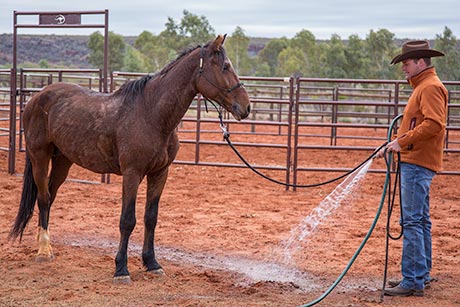
Before touching the horse with water, build his confidence by spraying the water around him first.
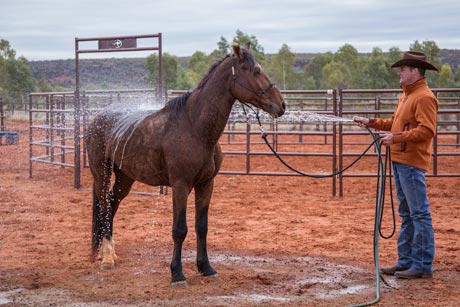
When you’re ready to spray the horse with water, start on his topline, the least sensitive area on his body.
Teaching Stage
1 Find an open area to practice the exercise so the horse has room to move his feet. Whenever you desensitize a horse to something, it’s important to do so in an open area where he has room to move his feet. As a prey animal, the horse has a flight or fight response, which means he either runs from danger or fights it. A horse would always rather run from danger than fight it, but if his ability to run is taken away from him, he’ll do whatever it takes to survive the experience. When every horse is born, his mother tells him to run from danger. If he even hears, smells or thinks there’s danger, RUN! Act first and think later. Your job is to teach the horse to completely ignore what his mother taught him. Instead, you’re going to teach the horse that if he thinks he’s in danger, he needs to stand still and relax and the danger will go away. You’ll do that by using the Approach and Retreat Method – approaching the horse with an object and then retreating (taking it away) when he stands still and relaxes.
Do not introduce water to the horse in an enclosed area like a wash rack or try to tie the horse up so that he can’t move his feet. If you do either of those things, I guarantee he’ll panic and try to fight his way out of the situation by kicking, biting, striking – whatever he can do to try and survive. A roundpen is the ideal place to practice this exercise because it gives the horse room to move, but not so much room that you’ll need a 300-foot hose to keep up with him. But the exercise can easily be done in the middle of an arena or outside on the lawn. Just be sure that you have enough hose to move around with the horse. The worst case scenario would be that the horse tries to run away from the water and you run out of hose to continue to follow him. Then the horse figures out that all he has to do to escape the scary object is run away from it.
2. Stand at a 45-degree angle to the horse’s shoulder, an arm’s length away. Hold the lead rope in the hand that’s the closest to the horse, keeping your hand up by his eye so that you can tap his front end away if he goes to push into you. Hold the hose in your opposite hand. Standing at a 45-degree angle to the horse’s shoulder is the safest position to be in because you’re too far in front to be kicked by a hind leg and too far to the side to be struck by a front leg.
3. Desensitize the airspace around the horse to water. Always start out by desensitizing the airspace around the horse. The last thing you want to do is walk straight up to the horse with the hose and immediately start spraying him down with water. Desensitizing the airspace around the horse gives him a chance to tolerate the object around him first. If the horse can’t tolerate the object around him, he’s not going to be able to tolerate it on him.
As a general rule, I start spraying the ground with water about 4 feet away from the horse’s legs. I keep the hose in the same position until the horse does two things: stands still and shows a sign of relaxing. Signs of relaxing include licking his lips, blinking his eyes, taking a deep breath, cocking a hind leg, lowering his head and neck or standing still for at least 15 seconds. As soon as he does both of these things, take the hose away and rub him with your hand.
At first, it’s likely the horse will want to move around to try to get away from the water. That’s OK. If he moves, just follow him wherever he goes, keeping the hose in the exact same position in relation to his body. The biggest mistake people make is taking away the water when the horse moves. If you take the hose away when the horse moves, you’ll teach him that if he wants the object to go away, all he has to do is run away from it. You want the horse to use the thinking side of his brain and stand still and relax.
As you’re desensitizing the airspace around the horse, be sure to keep his head tipped toward you. When the horse’s head is tipped toward you, if he went to move, his hindquarters would swing away from you so that you wouldn’t be in any danger of getting kicked, and he also wouldn’t have the leverage to drag the lead rope out of your hand. Remember, you can run faster than any horse that’s looking at you. You can run faster than a horse can run sideways and you can run faster than a horse can go backwards, as long as he is giving you two eyes.
Keep repeating the process until the horse is completely comfortable with the water being sprayed next to his body on both sides and doesn’t try to move away from it. Keep in mind that sometimes a horse won’t show you any of the five signs of relaxing, but if he stands still for 15 seconds, it is OK to retreat at that particular point because he’s telling you that he is not interested in running. He may still be a little scared, but at least he’s not moving.
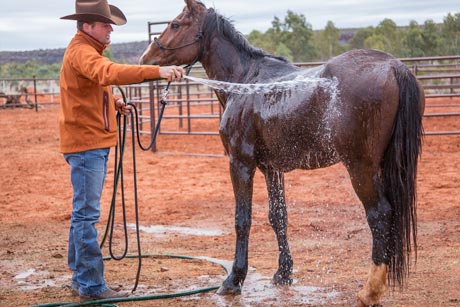
Use Approach and Retreat to work your way along the horse’s entire topline – 1) withers and back, 2) hindquarters, and 3) neck.
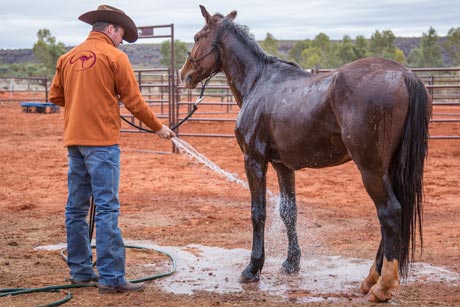
When the horse is comfortable with water being sprayed on his topline, desensitize his legs.
4. Desensitize the horse’s topline to water. When you have the airspace around the horse desensitized to the water, begin spraying his body, starting with the topline – 1) withers and back, 2) hindquarters and 3) neck – in that order. The horse’s topline is the least sensitive area on his body and that’s why I always introduce water to that area first. Use the same steps described above, approaching and retreating each area until the horse keeps his feet still and relaxes. Stay away from the horse’s legs and head this early in the exercise because they are the most sensitive areas on a horse’s body, and if you start with them, it’s likely the horse will become defensive. Make sure you work on desensitizing the topline on both sides of the horse.
5. Desensitize the horse’s legs to water. When you move to the legs, some horses will get defensive and kick out when the water hits them. Just ignore that behavior and keep spraying in the same spot until the horse stands still and relaxes. That’s why you stand at a 45-degree angle to his shoulder, because you’ll be too far in front to be kicked by a hind leg and too far to the side to be struck by a front leg. Eventually, the horse will realize that 1) the water isn’t hurting him, and 2) kicking does not seem to be making it go away, so he’ll stop kicking and relax. Be sure to desensitize the horse’s legs on both sides of his body.
6. Desensitize the horse’s face to water. The horse’s face should be the last body part you introduce water to. In fact, if the horse is really reactive about the water on his body, wait another day or two before introducing it to his face. Focus on getting his body really good, and then, when you start on his face, it will be much easier on both of you. Most horses are defensive about letting the hose near their face, because they’re afraid of the water getting in their ears. To calm the horse’s anxiety, turn the pressure of the hose down so that the water barely trickles out.
Then, still standing at a 45-degree angle to the horse’s shoulder, lay the hose just behind his ear and let the water run down his face and neck. Keep the hose there until the horse stands still and relaxes. When he shows a sign of relaxing, retreat by taking the water away. Then approach him with the hose again, this time working your way to the side of his face so that the water runs down his jaw. When he stands still and relaxes, retreat and take the hose away. Then you can approach him with the water again and lay the hose in the middle of his forehead so that the water runs down his face.
Practice this for a few days until the horse is completely relaxed with the water running down his face. Then you can start spraying his face with the water. Make sure the water pressure is not so high that it makes him feel uncomfortable. Basically, you just start spraying his face. Be careful not to spray the water so that it goes into his ears. Because you’re applying more pressure by spraying the water instead of just letting it run out of the hose, the horse will probably throw his head in the air. Keep his head tipped toward you and continue to spray the water on his face until he lowers his head a little bit. As soon as he does, instantly remove the water. Then spray his face again. Continue using Approach and Retreat until the horse remains relaxed while you spray his face. He may not be perfect the first day, meaning he might still throw his head up initially, but every day you’re looking for him to relax sooner, until eventually, he doesn’t throw it up at all.

I was able to spray Bundy’s face during the first session of desensitizing, but it may take more than one session to build a horse’s confidence enough to allow you to get his face wet.
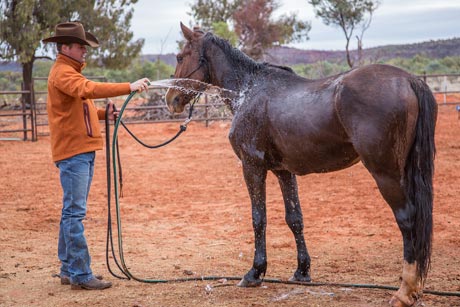
If you find that your horse is frightened of the water, try turning down the water pressure. Make the situation less scary for him.
Handler Mistakes
Retreating when the horse is moving his feet.
If the horse gets frightened by the water and starts to move away from it, it is important to keep the hose in the same position until he stands still and relaxes. Signs of relaxing are licking his lips, lowering his head and neck, blinking his eyes, cocking a hind leg, taking a deep breath or standing still for 15 seconds without moving his feet. As soon as the horse’s feet stop moving and he shows a sign of relaxing, retreat by taking the water away and rubbing him with your hand.
Letting the horse run over you or push you around.
When a horse gets frightened, it’s common for him to want to push into you. If your horse does that, use your hand holding the lead rope to whack him away. Use a “tap, tap, whack” rhythm with your hand to apply pressure to the horse’s jaw or neck. Do what you have to do to get the job done. It is very important not to let him move your feet. Remember, the more you move out of your horse’s space, the pushier and more disrespectful he will get.
Moving your feet too much.
If the horse starts to move around at any time during the teaching process, move with him, but try to move your feet as little as possible. For instance, if the horse runs around in a circle, try to pivot and keep your belly button facing his hindquarters. If you have to walk and drift with the horse, that’s fine. Follow him wherever he goes, keeping two eyes tipped toward you and continue spraying the water in the same manner until he stops moving and he relaxes.
Not keeping the horse’s head tipped toward you.
It’s very important to keep bumping the horse’s head toward you with the halter and lead rope to get two eyes on you. Remember, you can run faster than any horse that’s looking at you. You can run faster than a horse can run backwards and you can run faster than a horse can run sideways, as long as he is giving you two eyes. When you let the horse’s head and neck turn away from you, it gives him the opportunity to turn and kick you or run off and drag the lead rope out of your hand.
Retreating too early.
If the horse’s feet are moving, you can’t afford to take the pressure away. Most people stop spraying the water when the horse is still moving his feet. This is actually sensitizing the horse to pressure, not desensitizing him to pressure. Remember, the horse has to do two things before you stop spraying the water: 1) he has to keep his feet still, and 2) he has to show a sign of relaxing or stand still for at least 15 seconds. If he shows a sign of relaxing, but his feet are still moving it doesn’t count.
Being inconsistent with the body parts.
Remember to start desensitizing the horse to water in the airspace around him first. Then start spraying it on his topline: withers and back, hindquarters and neck. Then introduce the water to the horse’s back legs and then his front legs. And finally, turn the water pressure down and introduce the water to his face. It’s the easiest for the horse to understand what is expected of him if you introduce water to him in this way.
Moving on to the next body part too quickly.
If you find a part of the horse’s body that he doesn’t like the water touching, stay in that area until you’ve made an improvement. Don’t move on to another body part if the previous one is still jumpy or spooky toward the water. By skipping around too much you won’t be able to get the horse to accept water consistently. Moving on to the face too quickly. Make sure you have completely desensitized the horse’s entire body, on both sides, to the water before you even attempt to introduce it to his face. The face is one of the most sensitive areas on the horse’s body, and a lot of horses will get very defensive about water being run over their face if they aren’t properly introduced to it. It may take you two or three sessions before you can begin to introduce water to the horse’s face.
Trying to make the horse stand still.
Remember, you’re not trying to make the horse stop moving his feet. You are trying to set up a situation where he wants to stop moving his feet by himself. The more you try to make him stop moving his feet, the more trapped and claustrophobic he will feel, which in turn will make him want to keep moving his feet.
Not finding a starting point.
Start the exercise by desensitizing the airspace around the horse first. How far you have to initially start spraying the water away from his body depends on the horse. If he is really scared of the water, you might have to start 8 feet away from him. If he’s not scared of the water, you’ll be able to start spraying the ground 4 feet away from him. Do what you have to do to get the horse to understand that the water won’t hurt him. Remember, always find a starting point.
Not standing at a 45-degree angle.
Most people don’t see the importance of this step until they get hurt. If you stand in front of the horse and try to spray the water on him, he could get frightened and strike out, rear up or run over the top of you. If you stand too far back, he may react and get frightened and kick at the water, and unfortunately, kick you instead. Please learn from my pain and not your own. Never assume a horse is safe. Always make him prove it to you.
Not enough repetition and consistency.
Remember, consistency is your greatest ally. Inconsistency is your greatest enemy. Horses learn from repetition. Don’t race through the steps. Take your time and spend several days in a row working on the exercise. And remember, the more thorough you are on each side, the quicker the horse will learn.
Horse Problems
Horse gets frightened and moves his feet.
Keep his head tipped toward you and continue to spray the same area on the horse’s body with the water until he stands still and relaxes. If the horse doesn’t show any of the signs of relaxing, but stands still for 15 seconds, you can retreat at that time.
Horse tries to run into you.
If the horse becomes pushy and disrespectful, use your hand closest to him to drive him away. Don’t try to push him away from you because you will lose. Tap or whack him away on his jaw with rhythm to make him feel uncomfortable for pushing into you. Do it as easy as possible, but as firm as necessary.
Horse backs up.
If he backs up, just go with him and stay in position, keeping the water in the same area on his body. If he isn’t giving you two eyes, bump on the halter and lead rope to get his head tipped toward you. Remember, you can outrun any horse that’s looking at you. It doesn’t matter how far he runs backwards, just stay with him. He can’t back up forever. He will try to get you to think he can, but you know better. This is why it’s helpful to practice desensitizing him to water in a confined space like a roundpen, which will give him room to move his feet but won’t let him go very far.
Horse runs in circles.
Discourage the horse from running around you by bumping on the halter and lead rope with rhythm toward his withers. This will cause the horse to look at you and disengage his hindquarters. You can’t stop him from running around, but you can make him feel very uncomfortable for doing it. Every time he tries to run, bump his head back toward you. At the same time, continue to spray the water. Never retreat with the water until the horse stands still and shows a sign of relaxing.
Horse runs sideways.
Just drift with him while bumping his head toward you to give you two eyes. At the same time, continue to spray him with the water in the exact same spot so he doesn’t escape the pressure. When he eventually stands still and relaxes, retreat and rub him. Horse kicks at the water when it touches his back legs. Just ignore this behavior and keep spraying the water on his back legs. If you take the water away when he kicks, you’ll be teaching him that kicking is the right answer. Once he realizes that: 1) the water won’t hurt him, and 2) he can’t get rid of the water by kicking, he will eventually stop kicking by himself and relax. Spanking him every time he kicks will only cause him to be more defensive.
Troubleshooting
The horse just won’t stand still.
If the horse won’t stand still, try doing a groundwork exercise like Lunging for Respect Stage Two to get him back to using the thinking side of his brain. The more you make his feet move forwards, backwards, left and right, the more he’ll start to use the thinking side of his brain. When the horse is using the thinking side of his brain, he’ll be in the right frame of mind to stand still and accept the water. Then you can come back to desensitizing with the water and you should get a much better result.
Success Tip
Practice this exercise at the end of a training session.
If you practice this exercise at the end of a training session, the horse will be in the right frame of mind to accept the water and ready to stand still and relax. He’ll probably also be sweaty, and when you run the water over his body, it’ll feel good to him.
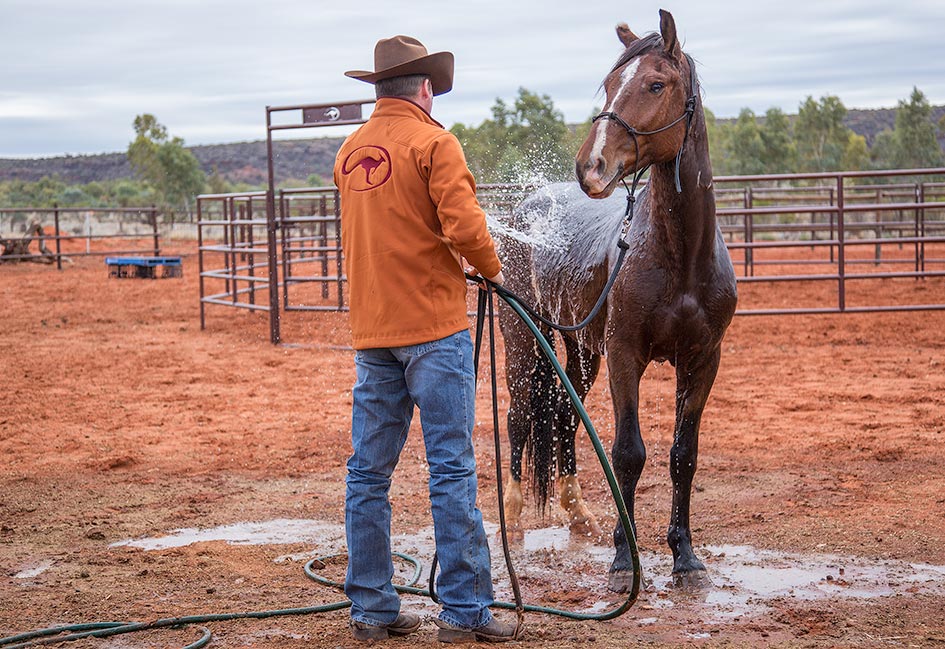
After a hard training session, Bundy was hot and sweaty and enjoyed getting hosed off with the water.

Want To Learn More? SIGN UP FOR OUR LOYALTY PROGRAM
Master your horsemanship training through Clinton’s step-by-step method videos by joining the No Worries Club today. Becoming a club member ensures you get VIP pricing on all of Clinton’s must-have training tools and resources. Plus, you’ll enjoy all the phenomenal benefits that come with club membership!



